Project Management in the Workplace: Implementation and Self-Development Plan
| ✓ Paper Type: Free Assignment | ✓ Study Level: University / Undergraduate |
| ✓ Wordcount: 5493 words | ✓ Published: 06 Jun 2019 |
Contents
1. Provide a critical assessment of the usefulness of project management tools and techniques. 3
3. Critically evaluate your ability to manage a project, use feedback from others to evaluate your ability to plan and implement a project, identifying strengths and weaknesses. Create a self-development plan to improve your own performance in managing projects. 12
4. References 17
5. Gantt chart/Pert Chart critical pathway 19
Budget plan
Stakeholders
Risk assessment
Introduction
The European Management Journal, states, “Project Management has become a core business process for most organisations”. (Maylor, H., 2001). Project management begins with a definition of a project, in this assignment it is a new kids barbers opening. Project Management allows managers to quickly understand information such as, who is working on project tasks? When will the tasks be accomplished? and how the tasks relate to the overall project? Throughout this assignment its will be looking at the different stages, responsibilities/ risks and budgets. The tools used to develop projects is the main key to success “Project management is the application of knowledge skills and tools.” (Wiley, J., 2017). In the International Journal of Project Management, a survey shows the project’s success rates, a remarkably high proportion of 41% were reported to be completely successfully. White. D (2002). This is due to the right tools and techniques being used. International journals claim, “Tools and techniques are one of the key elements in project process, numerous tools are available to support the various phases of the project.” (Raz, T., 2001).
- One project management tool is a Gantt Chart, they are simple and effective to use. Gantt Charts are horizontal bars charts that show the dependencies between the tasks and estimated time which the will be completed. It allows planning time and resource management and gives indication as to how long the project will take start to finish. Research shows “Gantt Charts are the favourite project plan representation because it’s really easy to view.” (Smith, T., 2016). There are mixed reviews on this statement as one Journal suggests Gantt Charts are losing their popularity, it argues that Gantt Charts pull a project manager’s focus away from the project and onto preceding pretty graphs that don’t really match reality. (Asoravala, 2006). Others claim that the charts are created only to please higher organisations and therefore a distraction to the actual project.
The Gantt Chart itself would not give detail costing or back up plans, and would then need to revisit and revised accordingly, the horizontal bars do not necessarily mean more resources required. For example, a bar may appear shorter in comparison to another task it may require more resources than the longer bar which may only require one person to carry out the task. (See appendix 1).
According to Project Management Journal Kumar stated, “Gantt Charts are a powerful and the most preferred visual tool”. (Kumar, 2005). It is one of the most preferred tools by most of the project managers, along with the Pert Chart with a critical pathway to back it up.
A critical path “effectively copes with a number of activities, data, and dependencies between activities involved.” (Milosevic, N. & Martinell, D., 2016). The Pert chart analysis averages three different timescales, the shortest, realistic, and worst case to predict due dates. The Pert chart is centred around important milestones, the most important milestone is the final due date. Not all tasks in a project are dependent and can run parallel, however, to determine the critical path of a project the dependencies need to be determined. (See appendix 2).
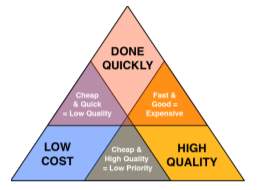 The Pert Chart is very popular for project managers, benefits of Pert Charts include making uncertain deadlines more predictable which shows a clear order to complete tasks. It improves communication during the project and allows the organisation to commit to the project that are relevant to its strategic positioning. However, there is one major downside, if the calculations are inaccurate any delay will create a bottleneck and affect the final delivery date. That is where a Gantt Chart may step in for simpler and visual manner.
The Pert Chart is very popular for project managers, benefits of Pert Charts include making uncertain deadlines more predictable which shows a clear order to complete tasks. It improves communication during the project and allows the organisation to commit to the project that are relevant to its strategic positioning. However, there is one major downside, if the calculations are inaccurate any delay will create a bottleneck and affect the final delivery date. That is where a Gantt Chart may step in for simpler and visual manner.
After all there are only three variables in a project and juggling three things is relatively a simple task. These are time, cost and quality, their interrelationships are often illustrated as a triangle.
Another tool used is a budget plan, this shows each relevant item, its costs against the day week or month in which it is incurred. For many projects it may be necessary only to plan and account for external costs such as, goods and services purchased outside the project. “Many organisations are perfectly happy with this type of budget, where as some go a little further wanting to see the internal staff costs of project.” (Watson, M., 2002) See appendix 3.
The international Journal of Project Management argues the problem with a budget plan is the trade-off problem with the risks. If the risks are higher and occur more than predicted it may push the project budget towards a negative side. “Cost reduction efforts on the other hand are sometimes associated with high risks. Project managers face the problem to balance budgets and risks in the planning stage.” (Sato, T., 2013).
An alternative to a budget plan would be a cost benefit analysis (CBA). This analysis looks at both quantitative and qualitative factors to determine the financial viability of a project. “In cost benefit analysis the decision rule is in principle and straightforward.” (Gray, A., 2000). According to research “cost benefit can be applied in two ways, the human capital approach, the principles contributions is linked to what they are paid or the approach on individuals.” (Robinson, R., 1993). Each method has its disadvantage’s, the most successful that has been found so far is the willingness to pay approach. There are still problems with the cost benefit analysis application and is not universally suited to all projects and should be used where appropriate. For this project a budget plan will be provided instead.
- A project management life cycle is the management process and projects that can be broken up into well-defined phases to form a life cycle. Artlo the author states “the reported life cycle is typically illustrated by project processes that range from project initiation to project closure.” (Karlos, A., 1999).
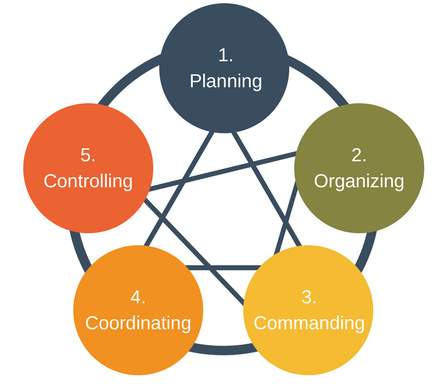
Henry Fayol, ‘The Five Functions of Management’ (1916)
According to management theorist Henry Fayol (1841-1925) the main responsibilities of management is; planning, organising, command, co-ordination and control. These responsibilities will be used throughout this project plan. First there is the initiation phase.
Initiation Phase
The Project initiation phase is the first phase in the Project Management life cycle, as it involves starting up a project. This is where Project Manager can start defining the project objectives, scope, and purpose. The project sponsor is the L’Oréal team.
All children despise having their hair cut, we have all experienced children screaming, kicking and crying refusing to let the stylist/barber near them. There are plenty of salons and barbers around us catering for females and males but not for children. This opportunity has arisen to re-open a barber as a successful ‘STRESS FREE KIDZ CUTZ’ (sic) barbers. This will be kid themed featuring a child friendly environment being provided by specially trained employees, a babysitter to entertain the children, brightly coloured furniture, child attracting fittings, play place, special scissors and equipment. The styling chairs will feature cartoons, pirates and princess patterns. The mirrors in front of the chairs will have tablets fitted so that the kids can be occupied whilst having their haircut. The waiting area is called the play place, a fully qualified professional babysitter with a complete DBS check will be in charge who will provide great entrainment and lots of fun. For the older kids they will have the option to have their nails painted to stop them getting bored.
‘Stress free kidz cutz’ (sic) will be a limited company, it will have a receptionist, a manager, four barbers, part time nail technician and IT person, babysitter, receptionist and a junior cleaner, they will be payed a basic wage with targets to hit to gain commission and boost their pay. All liability and profit will fall back on the owner, ‘Stress free Kidz Cutz’ (sic) will be located at 19 Bridge Street, Cardiff, SA18 RFT. It is a very busy part of the city with lots of attractions around such as museums and fast food restaurants which are popular with families, e.g. McDonalds, and more. The premises is a rented property of 500 ft squared with the monthly rent costing £500. A small business loan of £10,000 has been granted by the bank to get this business up and running, along with personal savings of £5,000.
The strategic financial partner is the accountant whose purpose is to monitor the flow of business money and come up with new solutions to increase the amount available to the business. Strategic marketing will help the business grow at a low cost and strategic supplier who will supply everything the business needs. There is no direct competition for ‘Stress Free Kidz Cutz’ (sic) as there is a large gap in the market for this kind of business in the area, on the flipside of this there are little barbers opening new shops up down the smaller streets however there is no reason why this business shouldn’t be successful.
The target market will include the parents living in the area and on the outskirts of the location, with kids age from 2 months to 13 years old girls and boys. The total for this project is £15,000, and a timescale of 7 months to be up and running. The closing of this project will be done when the first day of ‘Stress Free Kidz Cutz’ (sic) will start giving their services to the customers the children.
Planning phase
To show what the project aims to achieve, a project initiation document is shown below to outline and plan the project, along with a cost budget plan to show the cost effectiveness of the project.
| Project initiation document (PID) | Tick when complete ✓ |
| Section 1 – What is the project all about? | |
| Project Title Re-opening a barber’s shop. The name is ‘Stress free Kidz Cutz’ (sic) | |
| Background There are plenty of salons for ladies and gents, but not for children, if you do come across a salon to cut children’s hair, the employers don’t come across professional or patient. Stress free Kidz cutz will be the first of its kind in Carmarthenshire, therefore it will be trend setter. Children dislike having their hair cut and can be a challenging task for all. | |
| PurposeThe purpose is to bring a child friendly environment, to be successful and gain loyalty and commitment from clients, and eventually for the business to expand and become well known. | |
Objectives (and how they will be measured)
Will b – this will measured by asking feedback from clients in the form of a questionnaire.
This will be measured by monthly reviews, one to one with management and have the opportunity
Up to date training and courses to attend every 6 months to a year. |
|
| Project scopeAll employers will be included in the project. | |
| Exclusions from scopeNone | |
Deliverables (including dates of completion)
|
|
Constraints and assumptions
|
|
| Section 2: Why should this project go ahead? | |
| Business case: Project BenefitsBy re opening a shop as a kid’s barbers, it aims to provide the best quality of haircuts and experience for children. Make a reasonable profit. A babysitter who will entertain all ages is unique whilst having the option to get your nails done the same time. Birthday packages available also. Large amount of Media and advertising to be shared and followed. | |
| OptionsPurchase of equipment
Leasing of equipment Introducing game consoles in the future |
|
| Cost and TimescaleExpected timescale to be 7 months for the implementation at an estimated cost of £15000. | |
| CostSee budget plan in appendix 3 | |
Risk Analysis: Risk Identification
|
|
Risk prevention
|
|
| Risk ManagementEnsure remote monitoring on customers and employees and regular security updates on tablets and equipment. | |
| Risk MonitoringRemote monitoring by project management and employees to report risks when they appear (see appendix 4) | |
| Section 3: Who will work on the project? | |
Roles and Responsibilities
|
|
| Names of: Project SponsorL’ Orel Team | |
| Project Manager (PM)Stress free Kidz cuts. | |
| Section 4: How and when will the project be delivered? | |
| Initial Project Plan | |
| Assignments/Milestonesapply for bank loan start project 16/02/2018
Rent a property 02/03/2018 Reregister the business/ insurances 16/03/2018 Health and safety /constructionelectricians and plumbers 10/07/2018 Advertise business and staff/ interviews and hiring 05/07/2018 Qualifications checked/uniforms ordered and delivered 04/08/2018 Opening day 05/08/2018 |
|
| Schedule (Gantt Chart)See appendix 1 | |
Human Resource Requirements: Project Team
|
|
| Support StaffNot required | |
| Additional staffNot required | |
| Project Control: Monitoring mechanismsMonitoring to take place on weekly conference call/ weekly email update between managers and employees. | |
| Communication channels and schedulesPlan communications is the process of determining project stakeholder information needs and defining communication approach. This part of the plan includes the process required to ensure timely and appropriate collection, distribution, storage and ultimate disposition of project information. Following is the communication plan table. (see appendix 5). | |
| Quality ControlThere is no compromise on quality. It is made to sure that each customer gets the best quality from our employees and the barbers. Ensuring quality is also enlisted in the job description of each of employees. The manager and employees will eliminate any hurdle that will come in the way of delivering quality services and ensuring the best quality is delivered.
The effectiveness of the project will be shown in reports from customer feedback A Post-implementation Review is to be completed 6 months after the re-opening of the barbers. |
Communication
A communication plan needs to be created before the execution phase can be entered. This shows how stakeholders in the project will be informed of the progress in the project. Stakeholder are; the barbers stakeholders include project manager, barbers, junior cleaner, babysitter, receptionist, customers, L’Oréal the supplier, I.T employee, nail technician, marketing employee and accountant. This part of the plan includes the processes required to ensure timely and appropriate collection, distribution, storage, retrieval and ultimate disposition of project information. In the Journal of Change Management (2004) Goodman and Tuss emphasise that employees need communication during times of change, by keeping them informed will reduce uncertainty. Following the communication plan table, this approach will be used in the project. (Appendix 5)
Change management
All change requests will be documented, submitted to, and passed by the project manager and team leaders for impact and project necessity prior to project management approval. If the change is approved the project schedule, scope, and budget will be updated accordingly and communicated to appropriate stakeholders in accordance with the communications plan. The project management and team will communicate the approved change and updated schedule to the staff responsible for implementing the change.
Execution phase
This is where the project execution is carried out, whilst procuring resources and managing stakeholders. Controlling/monitoring happens in this phase. The quality is monitored as well as a scope creep, and cost/time allocations are watched to keep things in the budget. By following the project plan from the planning stage, this will allow the project manager to compare the progress to the project milestones and Gantt Chart/ Pert to ensure that tasks are being completed in timely manner and quality standards. The use of a Pert chart is highly subjective and subject to management experience. Weekly calls and emails updates to be held between project manager and the stakeholders, at each stage of the project. This will allow the Project Manager to air any concerns and address issues without taking time to physically meet, once execution phase is complete, a phase review will take place to ensure that the project has met all planned objectives before entering the closure phase.
Closing phase
This phase is where the project is finalized and where the deliverable service is given to the customers and the stakeholders are told of the completion of the project. Sage journal states “Successful project completion is contingent upon members working together effectively as a project team.” (Kloppenburg, T., 1999). However, if the team is dysfunctional behaviours prevail, schedules slip, costs overrun, output quality diminishes and in extreme cases the project will fail. To gain feedback, the project manager will conduct a post implementation review to gage the effectiveness of the project from stakeholders and all the objectives set have been met. The review will take place 3 months from the opening day of the ‘Stress free Kidz Cutz’ (sic), this is enough time for constructive feedback on the barbers. To gather the feedback a multi choice survey will be sent out to customers and employees, if any complaints the customers will have a chance to express these. All feedback will help the business to make changes to become the most successful professional barbers with customer satisfaction as a main priority.
- In this project I assumed the role as a project manager, this was a new experience to me. This role contributed to the insights and ideas on how to re-open the barbers and how it would benefit the gap in the market, to grow within the future. I decided to use the Smaller Projects method (SP). This is written by Mike Watson (2002), it is a practical guide to incorporating principles of project management to smaller projects simple and easy. Watson claims that his method is easy to understand and use and anyone without much project management experience can benefit from this experience. All my knowledge and charts came from following this book. Watson states “Many methods and techniques used in traditional project management look like sledgehammers when directed at smaller projects, so this system can be used easily to create a way of controlling smaller projects in any environment.” (Watson, M., 2002).
Many of articles refer Watson as a ‘management guru’. The Journal of management study argues this, “Watson defines managers as passing flows of ideas is one way that he relies on an academic cooperation of knowledge”. (Clark, T., 2002). Other articles state, “Watson proves favourable to the system approach which with its carefully crafted foundations, seems to offer much more to managers”. (Jackson, M., 1995).
The PRINCE2 method seems to be the most popular approach. When working on a project again depending on what the project was but I would use this method as it’s a very powerful tool to support project managers in planning and managing a project. Harris states “PRINCE2 is probably the most widely used project scheduling tool in use today.” (Harris. P., 2008). This is because it is detailed and clearly identifies areas of weakness and always proposes a way to work around any problems that occur. (Hughes. L. D., 2017). My project management style was underpinned by Harold Kerzner strategic planning for project management maturity model. This was a useful model to help me plan this project.
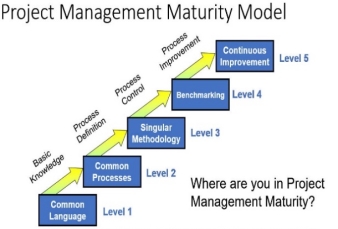
Harold Kerzner, “Strategic Planning for Project Management Using a Project Management Maturity Model”, 2001, John Wiley & Sons
My strengths throughout this project was the use of the Gantt chart and the Pert chart. The use of the Gantt Chart ensured that the project kept to schedule which means the project was a whole lot easier to manage. The Gantt could have been divided into smaller categories to ease factors and have a more detailed plan. The Pert chart backed up the Gantt chart with the critical path. The Journal of Multidisciplinary suggested, “The critical path is the path of activities, which represents the longest total time required to complete the project.” (Naveenchandra, N., 2017). A delay in any activity in the critical path causes a delay in the completion of the project. However, this was a good way of spotting a problem; “It is a brilliant technique to determine how much time a project needs before its completed, a distinguishing feature of Pert is its ability to deal with uncertainty in activity completion time.” (Cay, Et.al, 2004).
Although the project was a success it highlighted some weaknesses, the use of the budget plan was one as I followed the method of SP. It recommended to use a budget plan, this led to a few complications. A budget plan is a statement of the amount of money available to spend over a period.” Budget plan includes an outlined plan for how the money will be spent, with a breakdown of items, it will be spent on. It would have been more effective by using a cost benefit analysis”. (Wen, W. & Wong, K.W., 2005). The cost benefit analysis would have been more effective as it’s a straight foreword tool to use. When using the cost benefit tool, it includes the cost to introduce the project, perform it and support the changes resulting from it. Cost benefit evolves through the life of the project, developing in detail and accuracy. This would have been more suitable.
Within this project, float was not considered, luckily everything went to plan with no serious hiccups. This is down to a smaller project, however because of the dynamics and uncertainties that arise within the projects the expected delays do occur, and adversely affect the planned schedule. Contactors often need to change the resources, or the duration of activities or start dates, this would be possible if the float was considered. According to the Journal of construction “Delays to activities that are not on critical paths may not affect the final completion date of the project, however unplanned consumption of float reduces the ability to absorb schedule changes and can result in extra cost.” (Kim, K., & Garza, J., 2013). “Disputes can be avoided by using a method to measure the cost of float consumption objectively to apportion the float on a reasonable basis.” (Abingdon, M., 2013.)
Feedback
Feedback is a major key within project management. To get an honest opinion to review my ability to project mange, I will create a confidential questionnaire sent to the project team through email. “It arises from many different directions and dimensions, for an impact to be made these issues need to be acknowledged and tackled together to improve.” (Brod, D., 2013).
Here are some questions I will ask:
- Did you feel that the project was successful overall?
- Did you feel the project manager listened to you?
- Was the project manager approachable?
- Did you feel supported through out by project manager?
- Any other additional feedback you’d like to add?
For future projects I would consider using Bruce Tuckman’s Model of ‘Stages of Group Formation’ to engage the whole team in the process. The 5th stage of this model is titled the ‘adjourning stage’, which looks at the team from a wellbeing point of view and may suggest changes in approach in future projects.
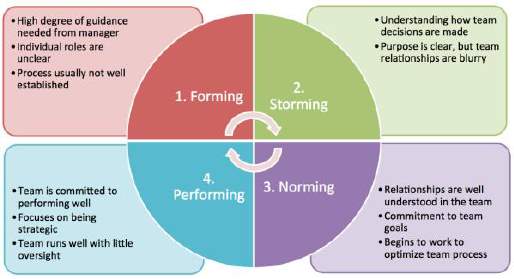
Bruce Tuckman, ‘Five Stage Model of Group Development’
Self-development plan
| Development goals. | Knowledge/skills. | Actions to develop. | Deadline. | Support. | |
| Short term. | Consider all outcomes. Gained knowledge and experience | Knowledge / research skills. | More research speaks to project mangers | Ongoing. | Training, courses, meetings with project managers |
| Gained experience through managing a smaller project | Management, communication, knowledge. | Next project larger project. | Work on 2 in 18 months | Meetings, observations, take notes. | |
| Long term. | Communication skills and confidence | Listening, approachable, management. | Work alongside project manager, coaching and shadowing project managers. | Ongoing. | Feedback, listening taking notes, support from project managers |
| Set a good example/ lead by example | Delegate, listening, calm, positive, | Feedback from team members. | Ongoing | Attending courses |
Conclusion
This report covered everything in the making of a project. The SP method was the guide throughout. Managing the change process throughout a project life cycle is complex and should be understood, planned for, implanted and measured by the project manager. The aim was to develop an assessment tool to measure to change dynamics across the 4 stages. The negatives have been recognised and can learn from them, however the positives were discovered too. In the future bigger complex projects will be achieved.
- References
Books
Boad. D (2013) Feedback in higher profession education. 2 Pork Square, Milton Park, Abington, Oxon, OX14 4RN. Pp 8-10
Karlos. A (1999) Project management.Helsinki University of technology, Finland, PO box 9500 02015 pp. 4-10.
Kerzner.H (2017) project management a system approach to planning, scheduling and controlling, twelfth edition. John Wiley & sons, 111 River Street, Hoboken, NJ07030 pp. 63- 160.
McGrath. J & Bates.B (2017). The little book of big management theories. Edinburgh Gate, Harlow CM20 2JE pp. 58-117.
Mike.W (2002) Managing smaller projects. Multi-Media publications Inc, Lakefield, Ontario, Canada, K0L 2H0 pp. 1- 119.
Milton. R (2005) Successful Project management- A step by step approach with practical examples. 222 Rosewood Drive, Danvers, MA 01923 pp. 18-24.
Journals
Abington. M (2013) Cost impact of float loss on project with adjustable activity deration. Journal of the operational. Vol 64 issue 8 pp 1147-1156
Asoravala. A (2006) Defending the Gantt chart.) Software development: San Francisco. Vol 47 issue 7 pp. 14- 21.
Boer, F (2000) Valuation of technology using real option. Research Technology Management Vol.43 issue 4, pp. 26-30.
Fan et al (2005) Choosing in a project risk handling strategy an analytical model. International Journal of production economics. Vol 112 issue 2 pp. 700-713.
Gray. A (2000) Using cost effectiveness information. British medical Journal Vol 320 issue 7229 pp. 246-249
Kempfer.L (1994) Systems are required to manage, schedule and monitor tasks resources and costs. Computer-Aided engineering CAE, Cleveland. Vol 13 issue 4 pp 18
Kim.K & Garza. J (2013). Phantom Float. Journal of construction engineering and management Vol 1129 issue 5 pp 507-510
Maylor. H (2001). Beyond the Gantt chart project manager moving on. European management journal. Vol 19 issue 1 pp. 92-102.
Naveenchandra. N (2017) Triple A research critical path analysis. Journal of multiciliary. Vol. 1 issue 1 pp 37-64
Raz. T (2001). Use and benefits of tools for project risk management. International Journal. Vol 19 issue 1 pp9-17.
Suto. T (2013). Optimum budget allocation methods for projects with critical risks. International Journal of project management.Vol 31 issue 1 pp. 126-135.
Tuckman. B (1977) Stages of small group development revisited. Sage journal. Vol 2 issue 4 pp 19-77.
Wen. W & Wong. K. W (2005) A knowledge based intelligent decision support system for natural defence budgeting. Science direct. Vol 28 issue 1 pp 55-56
White. D (2002) Current practice in project management- an empirical study. Vol 20 issue 1 pp 1-11
Websites
Cay.ET.AL (2004) the cost analysis of satellite images by using GIS by the pert commission. Available at https://www.isprs.org/proceedings/xxxv/congress/comm4/papers/37l/pdf accessed on 14th September
NASDAQ QM S release distribution channel New York (2018) BQE core business management platform adds Gantt charts to simplify project management. Available at https://search.proquest.com/docview/2019310825?accountid=130472 accessed on 14th august.
Kloppenborg. T (1999) Sage Journals. Leadership in Project Life Cycle and team character development. Available at https://doi.org/10.1177/875697289903000203. Accessed on 2nd September
Robinson. R (1993). Cost benefit analysis. Available at https://doi.org/10.1136/bmj.307.6909.924 accessed on 2nd September
Smith. T (2016) Business and Economics personal information. HR doesn’t manage projects, projects manage HR. Available at https://search.proquest.com/docview/1954650221?accountid=130472 accessed on 26th August
- Appendix 1 – The Gannt Chart
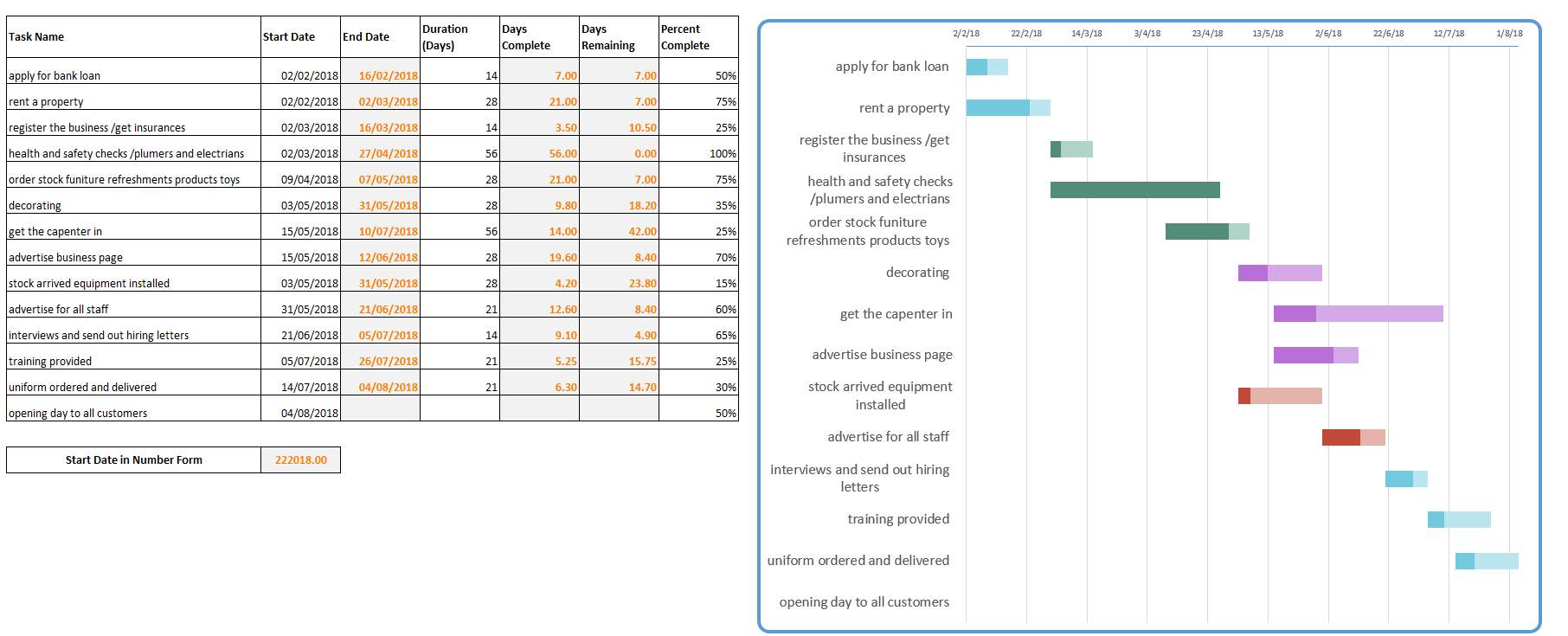
Appendix 2
Pert chart critical pathway.
Activity 4 health and safety checks, along with plumbers and electricians. Duration 2 months


Activity 8 advertising the business page, Facebook, twitter Instagram and loyalty cards duration 1 month
Activity1 Bank loan
Duration 2 weeks


OPEN DAY TO CUSTOMERS,
Activity 13 uniforms ordered and delivered duration 3 weeks
Activity 9 stock and furniture delivered, and equipment installed. Duration 1 month
Activity 2 rent a property duration 1 month
Activity 3
Register the business get insurances duration 3 weeks
Activity 6 Decorating duration 1 month












Activity 5 order the stock, furniture, refreshments, products, toys LCD monitors. Duration 1 month
| Task Name | Start Date | End Date | Duration (Days) | Days Complete |
| apply for bank loan | 02/02/2018 | 16/02/2018 | 14 | 7.00 |
| rent a property | 02/02/2018 | 02/03/2018 | 28 | 21.00 |
| register the business /get insurances | 02/03/2018 | 16/03/2018 | 14 | 3.50 |
| health and safety checks /plumbers and electrians | 02/03/2018 | 27/04/2018 | 56 | 56.00 |
| order stock furniture refreshments products toys | 09/04/2018 | 07/05/2018 | 28 | 21.00 |
| decorating | 03/05/2018 | 31/05/2018 | 28 | 9.80 |
| get the carpenter in | 15/05/2018 | 10/07/2018 | 56 | 14.00 |
| advertise business page | 15/05/2018 | 12/06/2018 | 28 | 19.60 |
| stock arrived equipment installed | 03/05/2018 | 31/05/2018 | 28 | 4.20 |
| advertise for all staff | 31/05/2018 | 21/06/2018 | 21 | 12.60 |
| interviews and send out hiring letters | 21/06/2018 | 05/07/2018 | 14 | 9.10 |
| training provided | 05/07/2018 | 26/07/2018 | 21 | 5.25 |
| uniform ordered and delivered | 14/07/2018 | 04/08/2018 | 21 | 6.30 |
| opening day to all customers | 04/08/2018 |
Activity 5 order the stock, furniture, refreshments, products, toys LCD monitors. Duration 1 month
Activity 7 get the carpenters in duration 2 months
Activity 7 get the carpenters in duration 2 months
Activity 10 advertising for all the staff duration 3 weeks
Activity 10 advertising for all the staff duration 3 weeks
Activity 12 training duration 3 weeks
Activity 11 interviews/hiring letters sent out/ check qualifications & DBS check duration 2 weeks
Activity 11 interviews/hiring letters sent out duration 2 weeks
activity 2 + activity 4 + activity 8 = 4 months
activity 2 +activity 5+ activity 6 + activity 7 + activity 10 + activity 11+ activity 12 = 7 months Critical pathway activity 2+ activity 3+ activity 6+activity 9+ activity 13 = 4 months 2 weeks.
Appendix 3
The overview of budget plan.
Project investment.
| Item | Cost |
| Setup cost
Premises Working capital Marketing expense Preliminary expense |
£4,500
£1000 £800 £800 £1000 |
| Total | £8,100 |
Setup costs: it includes the bank loan, all the fixtures (4 x tablets), electricians/plumbers/carpenters.
Premises: The agreement of tenancy signed requires a month bond of £500, then £500 per calendar month.
Preliminary costs: They include buying of all the products required to start business, toys, refreshments.
Salaries
| Designation/ Type | Number | Monthly salary | Total Salary |
| Barbers | 4 | £700 | £28,000 |
| Baby sitter | 1 | £700 | £700 |
| Nail technician | 1 | £300 | £300 |
| Junior cleaner | 1 | £500 | £500 |
| Receptionist | 1 | £550 | £550 |
| I.T person | 1 | £300 | £300 |
| Total | £5,150 | ||
In the first 3 years, assumptions are that there will be 4 barbers, a junior cleaner, baby sitter, part time nail technician and IT person, until the business can build a reputation.
Some of the utility expense assumptions are:
| Utility | Monthly Expenses |
| Electricity | £200 |
| Gas | £200 |
| Telephone | £100 |
| Internet | £100 |
| Water | £200 |
| Total £ 800 | |
Total cost becomes:
| Type of expenses | Cost |
| Project investment | £8,100 |
| Salaries | £5,150 |
| Utilities Expense | £800 |
| Total | £14,050 |
Averaged on £15,00 to set to set up this business, which leaves project manager with a backup of a spare £950, just in case something was to go wrong or if the barbers have a quiet few weeks.
Idea on the prices that will be charged once up and running
| INCLUDES FREE BABYSITTING/ BALLOONS/ LOLLYPOPS
Kids first haircut, babies under 2 years old include a certificate with first lock of hair £10 Boys up to age of 10 (dry cut.) £12 Boys up to age of 10 (wash, cut and styled.) £15 Girls up to age of 10 (dry cut.) £14 Girls up to age of 10 (wash, cut and styled.) £17 Boys age 10-17 include wash £20 Girls age 10-17 include wash £25 Kids up styles from £20 Kids fringes £7 Nails painted £5 BIRTHDAY PACKAGES MAXUIM OF 6 £70 (include makeover/up style or nail polish /refreshments/music and snacks.) Loyalty card system every 8th cut free |
Rough idea on basic income the barbers will make in a month if all fully booked up.
Work hours for all except part timers are from 3pm -10pm (after school hours/same in holidays). The barbers will be open 6 days per week plus take away half hour for lunch, fifteen break afternoon and evening.
Appointment system will work with bookings every 45 mins, this calculates to available 8 appointments a day. Average bill works out to £13.
13 (average bill) x 8(appointments) x 4 (barbers) = £416 (a day.) 416 x 6 (days that barbers are open) = £2,496 9 (a week) 2,469 x 4 (every 4 weeks) = £9,900 ( making a month on average)
This is before tax and no holidays and sickness not included.
Appendix 4
Probabilities of risks effecting the project.
| Financial Risks | 20% |
| Operational Risk | 20% |
| Marketing Risk | 25% |
| Management Risk | 15% |
| Threats to new entities | 90% |
Appendix 5.
Communication channels.
| Deliverables | Type | Delivery method | Delivery frequent | Who is responsible? |
| Status reports. | Mandatory | Through e- mail and calls | After every 2 weeks | Project manager. |
| Stakeholders management strategy. | Proper documents through courier services | After 3 weeks. | Project manager. | |
| Updated documents according to emerging needs. | Mandatory | Proper documents through courier services | After every 4 months | Support department. |
| Meeting schedules reports. | Mandatory | Through e-mails and calls | After every 2 weeks | Project manager. |
Cite This Work
To export a reference to this article please select a referencing stye below:
Related Services
View allDMCA / Removal Request
If you are the original writer of this assignment and no longer wish to have your work published on UKEssays.com then please click the following link to email our support team:
Request essay removal



